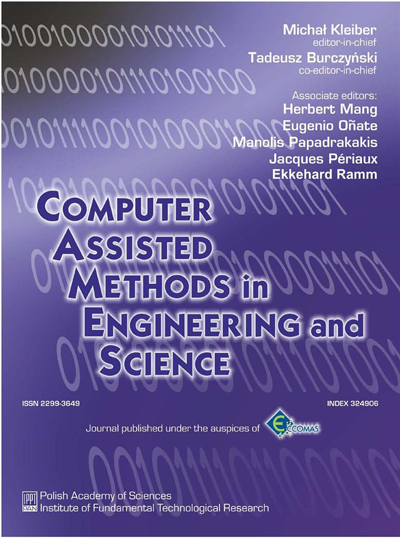Fuzzy weight neural network in the analysis of concrete specimens and R/C column buckling tests
Abstract
The paper describes the applications of back propagation neural networks with the ability to process input and output variables expressed as fuzzy numbers. The presentation of an algorithm for finding fuzzy neural network weights is followed by three examples of applications of this technique to the problems of implicit modelling of material and structure behaviour. The following problems are considered: prediction of concrete fatigue failure, high performance concrete strength prediction, and prediction of critical axial load for eccentrically loaded reinforced concrete columns.
Keywords
neural networks, fuzzy weight neural network, strength of high performance concrete, buckling of reinforced columns,References
[1] L.A. Zadeh. Fuzzy sets. Information and Control, 8: 338–353, 1965.[2] G.J. Klir, Bo Yuan. Fuzzy Sets and Fuzzy Logic – Theory and Applications. Prentice Hall, Upper Saddle River, NJ, 1995.
[3] J-Sh.R. Jang, Ch.-T. Sun, E. Mizutani. Neuro-Fuzzy and Soft Computing. Prentice-Hall, Upper Saddle River, NJ, 1997.
[4] M. Jakubek. Application of artificial neural networks to selected problems of experimental mechanics of materials and structures. PhD Thesis, Cracow University of Technology, 2008.
[5] M. Jakubek, Z.Waszczyszyn. Neural analysis of concrete fatigue durability by the neuro–fuzzy FWNN. Artificial Intelligence and Soft Computing, pp. 1075–1080, Berlin–Heidelberg–New York, Springer, 2004.
[6] K. Chudyba. The influence of material and geometric characteristics on the compressive load capacity of reinforced concrete columns (in Polish). Ph.D. Thesis, Cracow University of Technology, 1999.
[7] W.B. Cranston. Analysis and design of reinforced concrete columns. Research report 20, Cement and Concrete Association, 1972.
[8] http://www.ce.washington.edu/ peera1/, 2007.
[9] J. Kasperkiewicz, J. Racz, A. Dubrawski. HPC strength prediction using artificial neural network. J. Computing in Civil Engineering, 357–373, 1995.
[10] J. Kasperkiewicz, D. Alterman. Application of artificial intelligence methods for design of concrete mixtures. Proc. 47th Polish Conf. Civil Engineering, 331–338, 2001.
[11] E. Pabisek, M. Jakubek, Z. Waszczyszyn. A fuzzy network for the analysis of experimental structural engineering problems. Neural Network and Soft Computing, pp. 772–777, Heidelberg – New York, Physica-Verlag, A Springer-Verlag Co., 2003.
[12] K. Furtak. Strength of concrete subjected to multiple repeated loadings (in Polish). Arch. of Civ. Eng., 30: 677–698, 1984.
[13] Kaliszuk, J., Urbańska, A., Waszczyszyn, Z.: Neural analysis of concrete fatigue durability on the basis of experimental evidence. Arch. of Civ. Eng., 47: 327–339, 2001.
[14] M. Jakubek, Z. Waszczyszyn. Analysis of concrete fatigue durability by the neuro-fuzzy network FWNN. Arch. of Civ. Eng., 53: 3–22, 2007.
[15] M. Jakubek and Z. Waszczyszyn. Neural analysis of concrete fatigue durability by the neuro-fuzzy FWNN. In: L. Rutkowski et al. [Eds.], Artificial Intelligence and Soft Computing – ICAISC 2004, pp. 1075–1080, Springer, LNAI 3070, Berlin-Heidelberg, 2004.
Published
Jan 25, 2017
How to Cite
JAKUBEK, Magdalena.
Fuzzy weight neural network in the analysis of concrete specimens and R/C column buckling tests.
Computer Assisted Methods in Engineering and Science, [S.l.], v. 18, n. 4, p. 243–254, jan. 2017.
ISSN 2956-5839.
Available at: <https://cames.ippt.gov.pl/index.php/cames/article/view/102>. Date accessed: 31 may 2025.
Issue
Section
Articles




